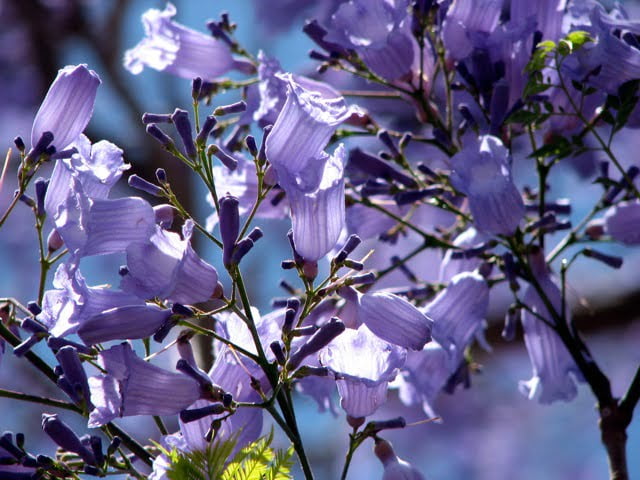
Genus Jacaranda, family Bignoniaceae.
When we think of the ultimate compliment, we often say something is breathtakingly beautiful. It takes our breath away for just a moment because it is so wondrous.
The breath is a delicate thing when we use it to describe a breath of wind, meaning the faintest whisper of a breeze.
It is a mighty thing when we understand the breath as the sustainer of our lives from the cradle to the grave.
The Kosha (sheath) that has to do with breath and life force is called Pranamaya Kosha.
It’s so interesting as a yoga teacher to notice how our students breath in class, or even to be attentive to our own patterns of breathing. I have a colleague who speaks quite breathlessly in instructing her students, even when she is exhorting them to breathe through their postures.
Why bother paying attention to something as commonplace as breathing? Because the breath interfaces so completely with our emotions and our mind activity. The ancient yogis understood from experiments with breathing that to influence the breath is to influence the mood of the mind and its thoughts.
If the breath is irregular or laboured, all we need to do at times is to relax. Relax the diaphragm, relax the whole physical body and the breath begins to re-establish itself in a more natural rhythm. As simple as letting go, which we know is actually very hard if we are talking about lifetime patterns. This is yoga territory.
The physical postures are indispensable in making room for the breath. In the Iyengar method, props, like the backbender, chairs, blocks, bolsters – all kinds of stuff to lie over – open the thoracic and abdominal cavities to the breath. Stretching and twisting and inverting feel good to the body, but they also shine a light into all those nooks and crannies overlooked for years.
As people grow older, they can become victims of the ravages of poor posture, diseases, unresolved injuries, stiffening and swelling of joints, even just the effects of gravity. All these take an enormous toll on breathing. If one’s breathing worsens over time, energy levels drop and thinking becomes dull. And, when one feels less energetic, all of the above problems can be exacerbated.
You know how it works, whether you’re young or old. You’re tired, you don’t want to move, and you become more lethargic – a debilitating cycle.
This is why it is important that a well-rounded yoga practice include pranayama, as well as asanas. A short practice is fine at first. Pranayama is so engaging that it will charm you, if you just give it a chance. Start now, keep it up, and you’ll have a money-in-the-bank kind of investment to draw on when you are older. A sort of life force superannuation.

0 Comments